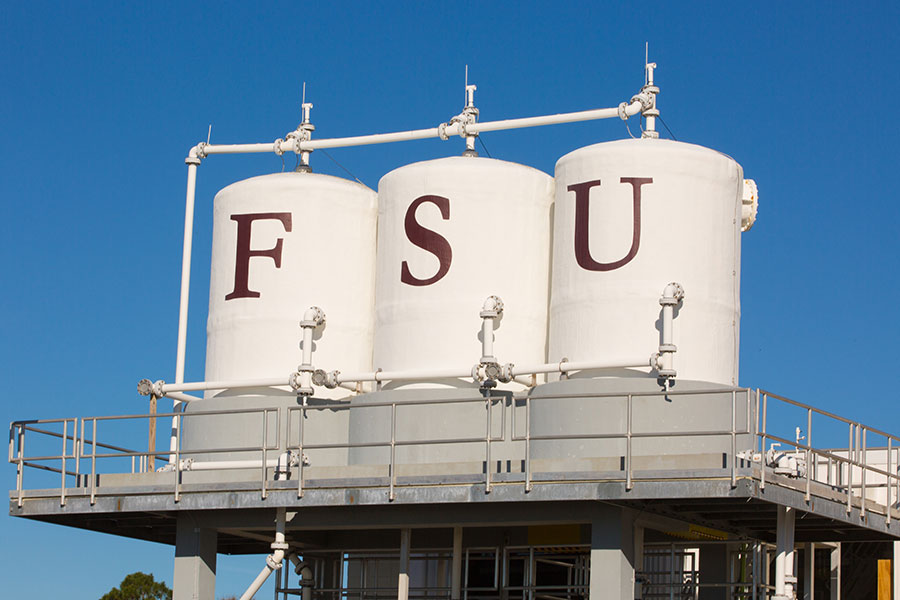
Florida State University has assembled a 23-member community advisory board to help guide researchers as they embark on an ambitious 10-year initiative to restore Apalachicola Bay and revive the region’s imperiled oyster industry.
“Appointing a board of community members is an important first step in the work FSU researchers will be doing to develop a scientifically backed plan to revitalize Apalachicola Bay,” said Vice President for Research Gary K. Ostrander. “The bay is a key part of life in the region, and we want to be fully engaged with the community here. They have a big part to play in our work.”
The project — the Apalachicola Bay System Initiative (ABSI) — is funded by a grant from Triumph Gulf Coast Inc., a nonprofit corporation organized to administer funds recovered by the state for economic damages that resulted from the 2010 Deepwater Horizon oil spill.
Triumph board member Matt Terry, a lifelong resident of the Florida Panhandle, emphasized the importance of the project for the area.
“The Gulf Coast fisheries were deeply impacted by the Deepwater Horizon oil spill,” Terry said. “I look forward to working with the Apalachicola Bay System Initiative in restoring Apalachicola Bay and the oyster industry to its pristine condition.”
Over the past few decades, natural and man-made disturbances have affected oyster populations, including changes in the water flow regime, overfishing, disease and hurricanes. The collapse of the Apalachicola Bay oyster fisheries has created huge economic hardships for Franklin County. Restoration of the oyster ecosystem will improve the local economy and overall health of the bay.
Felicia Coleman, director of the FSU Coastal and Marine Laboratory, said including the community is a vital part of the process. ABSI commissioned a stakeholders’ report from the Florida Conflict Resolution Consortium Consensus Center to examine preliminary concerns from the community about the causes of decline and approaches necessary to guide the future of Apalachicola Bay.
“There are people whose whole lives are wrapped up in the health of the Bay,” Coleman said. “There is a multigenerational history here, and people who have spent decades living and working in this area that will not be ignored. Talking to them can provide us with critical information and help inform both the scientific and management processes.”
Sandra Brooke, the scientific director of the project, agreed that inclusion of the local community was a high priority for researchers.
“Involvement of the local community is key to the success of this project,” Brooke said. “We need the perspective of those that live and work on the water.”
The 23 members of the community advisory board include local government officials as well as representatives from the seafood industry, recreational fishing industry and environmental groups.
The members are:
Georgia Ackerman, Apalachicola Riverkeeper
Chip Bailey, Peregrine Charters
Lee Edmiston, retired, Apalachicola National Estuarine Research Reserve
Jim Estes, Florida Fish and Wildlife Conservation Commission, Division of Marine Fisheries Management
Tom Frazer, University of Florida School of Natural Resources and Environment
Frank Gidus, Coastal Conservation Association
Anita Grove, Apalachicola City Commission
Chad Hanson, Pew Charitable Trusts
Jenna Harper, Apalachicola National Estuarine Research Reserve
Shannon Hartsfield, The Seafood Management Assistance Resource and Recovery Team
Kevin Landry, Apalachicola Oyster Company
Erik Lovestrand, Florida Sea Grant
Chuck Marks, Acentria Insurance
Vance Millender, Millender and Sons Seafood
Mike O’Connell, Saint George Island Civic Club
Smokey Parrish, Franklin County Commission
Becky Prado, Florida Department of Environmental Protection
Steve Rash, Water Street Seafood
Portia Sapp, Florida Department of Agriculture and Consumer Sciences, Division of Aquaculture
John Solomon, Apalachicola Chamber of Commerce
Chad Taylor, Riparian County Stakeholder Coalition
Paul Thurman, Northwest Florida Management District
TJ Ward, 13 Mile Seafood




